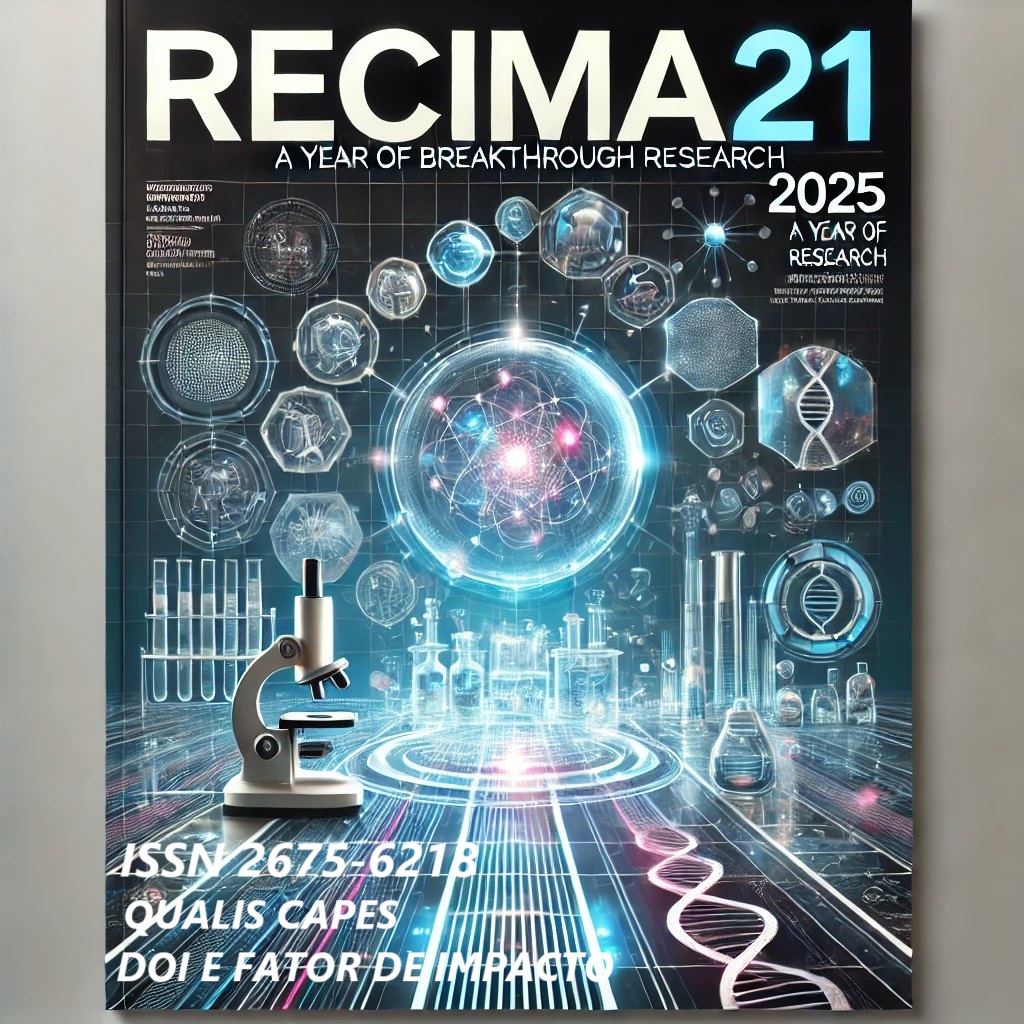STRATEGIES IN ORGANIZATIONAL PHYSICAL AND EMOTIONAL HEALTH WITH A FOCUS ON MINDFULNESS, NEUROSCIENCE AND SPIRITUALITY
DOI:
https://doi.org/10.47820/recima21.v6i11.6829Keywords:
Organizational Health, Mindfulness, Neuroscience, Spiritual Intelligence, SpiritualityAbstract
This article proposes a transdisciplinary approach to organizational health, integrating concepts from cellular biology, neuroscience, mindfulness and spirituality. Based on the analogy between the cell (functional unit of the human body) and the employee (essential unit in organizations), the study explores how stressful stimuli compromise homeostasis and generate systemic impacts in work environments. Chronic pain is presented as an expression of physical and emotional stress, especially in corporate contexts characterized by overloaded demands, pressure for performance and lack of mental health support. Practices such as mindfulness and guided imagery have demonstrated effectiveness, based on neuroscientific evidence, in emotional self-regulation, pain relief, and strengthening positive mental states. Spirituality, understood through the lens of spiritual intelligence, is highlighted as a strategic competency capable of expanding the sense of purpose, empathy, and resilience, promoting significant transformations in relationships and organizational results. Based on the emerging concept of the Quadruple Bottom Line – which integrates the economic, social, environmental and spiritual pillars – the article argues that organizational sustainability depends on valuing the integral human dimension. It is concluded that the well-being and expansion of individuals' consciousness are essential factors for the longevity and success of contemporary organizations.
Downloads
References
AHMAD, U. S.; NAWAB, S.; SHAFI, K. The role of islamic work ethics in spiritual leadership and inclusion practices relationship during COVID-19. The Journal of Asian Finance, Economics and Business, v. 8, n. 3, p. 943-952, 2021. Disponível em: https://doi.org/10.13106/jafeb.2021.vol8.no3.0943. Acesso em: 17 ago. 2025.
ANGELIDIS, A.; SOLIS, E.; LAUTENBACH, F.; VAN DER DOES, W.; PUTMAN, P. I’m going to fail! Acute cognitive performance anxiety increases threat-interference and impairs WM performance. Plos One, v. 14, n. 2, p. e0210824, 2019. Disponível em: https://doi.org/10.1371/journal.pone.0210824. Acesso em: 17 ago. 2025.
ASTAKONI, I. M. P.; SARIANI, N. L. P.; YULISTIYONO, A.; SUTAGUNA, I. N. T.; UTAMI, N. M. S. Spiritual Leadership, Workplace Spirituality and Organizational Commitment; Individual Spirituality as Moderating Variable. Italienisch, v. 12, n. 2, p. 620-631, 2022. Disponível em: https://www.researchgate.net/publication/366248549_Spiritual_Leadership_Workplace_Spirituality_and_Organizational_Commitment_Individual_Spirituality_as_Moderating_Variable. Acesso em: 17 ago. 2025.
BOEKEL, W.; HSIEH, S. Cross-sectional white matter microstructure differences in age and trait mindfulness. PloS one, v. 13, n. 10, p. e0205718, 2018. Disponível em: https://doi.org/10.1371/journal.pone.0205718. Acesso em: 16 ago. 2025.
COTRAN, R. S.; KUMAR, V.; COLLINS, T. Patologia estrutural e funcional. 6. ed. Rio de Janeiro: Guarabara Koogan, 2000.
DOTY, J. R. Mind magic: the neuroscience of manifestation and how it changes everything. United States: Yellow Kite, 2024.
FOURIE, M. Spirituality in the workplace: an introductory overview. In die Skriflig, v. 48, n. 1, p. 1-8, 2014. Disponível em: http://www.scielo.org.za/scielo.php?script=sci_arttext&pid=S2305-08532014000100014&lng=pt&nrm=iso. acessos em: 18 ago. 2025.
GARG, N.; PUNIA, B. K.; JAIN, A. Workplace spirituality and job satisfaction: exploring mediating effect of organization citizenship behaviour. Vision, v. 23, n. 3, p. 287-296, 2019. Disponível em: https://doi.org/10.1177/0972262919850928. Acesso em: 18 ago. 2025.
GHERARDI-DONATO, E. C. DA S.; DÍAZ-SERRANO, K. V;, BARBOSA, M. R.; FERNANDES, M. N. DE F.; GONÇALVES-FERRI, W. A.; CAMARGO JÚNIOR, E. B.; REISDORFER, E. The impact of an online mindfulness-based practice program on the mental health of Brazilian nurses during the COVID-19 pandemic. International Journal of Environmental Research and Public Health, v. 20, n. 4, p. 3666, 2023. Disponível em: https://doi.org/10.3390/ijerph20043666. Acesso em: 15 ago. 2025.
HAN, B.-C. Sociedade do cansaço. Petrópolis, RJ: Vozes, 2015.
INDRADEVI, R. Workplace spirituality: Successful mantra for modern organization. Journal of Critical Reviews, v. 7, n. 6, p. 437-440, 2020. Disponível em: https://bit.ly/4fJTOHZ. Acesso em: 18 ago. 2025.
JINICH-DIAMANT, A.; GARLAND, E.; BAUMGARTNER, J.; GONZALEZ, N.; RIEGNER, G.; BIRENBAUM, J.; CASE, L.; ZEIDAN, F. Neurophysiological mechanisms supporting mindfulness meditation–based pain relief: an updated review. Current Pain and Headache Reports, v. 24, p. 1-10, 2020. Disponível em: https://doi.org/10.1007/s11916-020-00890-8. Acesso em: 15 ago. 2025.
KARREMANS, J. C.; VAN SCHIE, H. T.; VAN DONGEN, I.; KAPPEN, G.; MORI, G.; VAN AS, S.; TEN BOKKEL, I. M.; VAN DER WAL, R. C. Is mindfulness associated with interpersonal forgiveness?. Emotion, v. 20, n. 2, p. 296, 2020. Disponível em: https://research-portal.uu.nl/ws/portalfiles/portal/234647687/Is_Mindfulness_Associated_With_Interpersonal_Forgiveness_.pdf. Acesso em: 16 ago. 2025.
KRAL, T. R. A.; SCHUYLER, B. S.; MUMFORD, J. A.; ROSENKRANZ, M. A.; LUTZ, A.; DAVIDSON, R. J. Impact of short-and long-term mindfulness meditation training on amygdala reactivity to emotional stimuli. Neuroimage, v. 181, p. 301-313, 2018. Disponível em: https://bit.ly/4fJTOHZ. Acesso em: 16 ago. 2025.
KRAWCZYK, N.; GREENE, M. C.; ZORZANELLI, R.; BASTOS, F. I. Rising trends of prescription opioid sales in contemporary Brazil, 2009–2015. American Journal of Public Health, v. 108, n. 5, p. 666-668, 2018. Disponível em: https://bit.ly/4fJTOHZ. Acesso em: 15 ago. 2025.
LEONG, D. Organizational homeostasis: a quantum theoretical exploration with bohmian and prigoginian systemic insights. Journal of Information and Organizational Sciences, v. 48, n. 1, p. 215-242, 2024. Disponível em: //jios.foi.hr/index.php/jios/article/view/2065. Acesso em: 15 ago. 2025.
MERCER LINDSAY, N.; CHEN, C.; GILAM, G.; MACKEY S.; SCHERRER, G. Brain circuits for pain and its treatment. Science translational medicine, v. 13, n. 619, p. eabj7360, 2021. Disponível em: https://pmc.ncbi.nlm.nih.gov/articles/PMC8675872/. Acesso em: 15 ago. 2025.
PIANARO, F. Acupuntura organizacional: coaching no suporte ao planejamento estratégico. Curitiba: Hellograf, 2013.
PREDOIU, R.; PREDOIU, A.; MITRACHE, G.; FIRĂNESCU, M.; COSMA, G.; DINUŢĂ, G.; BUCUROIU, R. A. Visualisation techniques in sport: the mental road map for success. Discobolul-Physical Education, Sport & Kinetotherapy Journal, v. 59, n. 3, p 245-256, 2020. Disponível em: https://discobolulunefs.ro/media/September2020.4.pdf. Acesso em: 17 ago. 2025. Acesso em: 17 ago. 2025.
PUTRA, I. G. B. N. P.; RAMANTHA. I. W.; GAYATRI, B. I. K. Beyond the triple bottom line concept: adding spiritual level dimension. Russian Journal of Agricultural and Socio-Economic Sciences, v. 146, n. 2, p. 106-114, 2024. Disponível em: https://rjoas.com/issue-2024-02/article_13.pdf. Acesso em: 18 ago. 2025.
RANGANATHAN, V. K.; SIEMIONOW, V.; LIU, J. Z.; SAHGAL, V.; YUE, G. H. From mental power to muscle power—gaining strength by using the mind. Neuropsychologia, v. 42, n. 7, p. 944-956, 2004. Disponível em: https://thebrain.mcgill.ca/flash/capsules/pdf_articles/Gaining_strength.pdf. Acesso em: 17 ago. 2025.
REINA, C. S.; KUDESIA, R. S. Wherever you go, there you become: How mindfulness arises in everyday situations. Organizational Behavior and Human Decision Processes, v. 159, p. 78-96, 2020. Disponível em: https://bit.ly/4fJTOHZ. Acesso em: 15 ago. 2025.
RICE, A. S. C.; SMITH, B. H.; BLYTH, F. M. Pain and the global burden of disease. Pain, v. 157, n. 4, p. 791-796, 2016. Disponível em: https://pubmed.ncbi.nlm.nih.gov/26670465/. Acesso em: 15 ago. 2025.
ROCHA, R. G.; PINHEIRO, P. G. Organizational spirituality: Concept and perspectives. Journal of Business Ethics, v. 171, n. 2, p. 241-252, 2021. Disponível em: https://doi.org/10.1007/s10551-020-04463-y. Acesso em: 17 ago. 2025.
RUDD, R. A.; ALESHIRE, N.; ZIBBELL, J. E.; GLADDEN, R. M. Increases in drug and opioid overdose deaths—United States, 2000–2014. American Journal of Transplantation, v. 16, n. 4, p. 1323-1327, 2016.
RUPČIĆ, N. Spiritual development–a missing and powerful leverage when building learning organizations. The Learning Organization, v. 24, n. 6, p. 418-426, 2017. Disponível em: https://doi.org/10.1108/TLO-07-2017-0071. Acesso em: 18 ago. 2025.
SOUZA, A. Liderança e espiritualidade: humanizando as relações profissionais. Santos: Simonsen, 2017.
TREEDE, R. D.; RIEF, W.; BARKE, A.; AZIZ, Q, BENNETT, M. I.; BENOLIEL, R.; COHEN, M.; EVERS, S.; FINNERUP, N. B.; FIRST, M. B.; GIAMBERARDINO, M. A.; KAASA, S.; KORWISI, B.; KOSEK, E.; LAVAND'HOMME, P.; NICHOLAS, M.; PERROT, S.; SCHOLZ, J.; SCHUG, S.; SMITH, B. H.; SVENSSON, P.; VLAEYEN, J. W. S.; WANG, S. J. Chronic pain as a symptom or a disease: the IASP Classification of Chronic Pain for the International Classification of Diseases (ICD-11). Pain, v. 160, n. 1, p. 19-27, 2019. Disponível em: https://bit.ly/4fJTOHZ. Acesso em: 15 ago. 2025.
VANDERWEELE, T. J.; BALBONI, T. A.; KOH, H. K. Health and spirituality. Jama, v. 318, n. 6, p. 519-520, 2017. Disponível em: https://rshm.hsites.harvard.edu/vanderweele-koh-balboni-health-and-spirituality. Acesso em: 18 ago. 2025.
VOWLES, K. E.; MCENTEE, M. L.; JULNES, P. S.; FROHE, T.; NEY, J. P.; VAN DER GOES, D. N. Rates of opioid misuse, abuse, and addiction in chronic pain: a systematic review and data synthesis. Pain, v. 156, n. 4, p. 569-576, 2015. Disponível em: https://pubmed.ncbi.nlm.nih.gov/25785523/. Acesso em: 15 ago. 2025.
VOLKOW, N. D.; BLANCO, C. The changing opioid crisis: development, challenges and opportunities. Molecular Psychiatry, v. 26, n. 1, p. 218-233, 2021. Disponível em: https://doi.org/10.1038/s41380-020-0661-4. Acesso em: 15 ago. 2025.
WIGGLESWORTH, C. As 21 habilidades da inteligência espiritual: o próximo passo da inteligência emocional. São Paulo: Cultrix, 2023.
ZEIDAN, F.; BAUMGARTNER, J. N.; COGHILL, R. C. The neural mechanisms of mindfulness-based pain relief: a functional magnetic resonance imaging-based review and primer. Pain reports, v. 4, n. 4, p. e759, 2019. Disponível em: https://pmc.ncbi.nlm.nih.gov/articles/PMC6728003/. Acesso em: 15 ago. 2025.
ZEMLA, K.; SĘDEK, G.; WRÓBEL, K.; POSTĘPSKI, F.; WÓJCIK, G. M. Investigating the Impact of Guided Imagery on Stress, Brain Functions, and Attention: a randomized trial. Sensors, v. 23, n. 13, p. 6210, 2023. Disponível em: https://www.mdpi.com/1424-8220/23/13/6210/. Acesso em: 17 ago. 2025.
ZOHAR, D.; MARSHALL, I. QS: Inteligência espiritual. Campinas: Viva Livros, 2012.
Downloads
Published
License
Copyright (c) 2025 RECIMA21 - Revista Científica Multidisciplinar - ISSN 2675-6218

This work is licensed under a Creative Commons Attribution 4.0 International License.
Os direitos autorais dos artigos/resenhas/TCCs publicados pertecem à revista RECIMA21, e seguem o padrão Creative Commons (CC BY 4.0), permitindo a cópia ou reprodução, desde que cite a fonte e respeite os direitos dos autores e contenham menção aos mesmos nos créditos. Toda e qualquer obra publicada na revista, seu conteúdo é de responsabilidade dos autores, cabendo a RECIMA21 apenas ser o veículo de divulgação, seguindo os padrões nacionais e internacionais de publicação.













